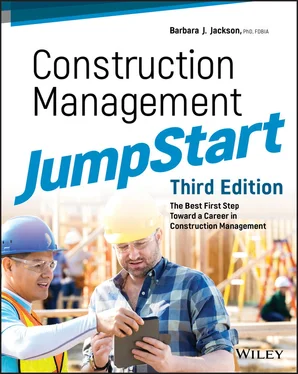Today, there are more than 160 four-year colleges and universities listed with ASC offering construction management curricula. The programs are typically identified as construction management, construction engineering, engineering technology, building science, or construction science, and they are often affiliated with colleges or schools of engineering, architecture, or technology. The educational opportunities available today are discussed in greater detail later in this chapter; see the “Educational Offerings” section.
New technologies are impacting every aspect of our lives. The construction industry is no exception. There are computer applications across all aspects of the construction management function: programs for estimating, scheduling, project administration, building design, cost accounting, project controls, quality control, and information transfer. Computers are available on every job site, and increasingly we are seeing all kinds of field mobility software and tablet computers being applied to every aspect of the construction management process that can be used to initiate a schedule or purchase order change in an instant. But the technology doesn't stop there. Technologies such as global positioning systems (GPS), computer-aided earth-moving systems, building information modeling (BIM), and virtual and augmented reality are allowing construction managers to enter and interact with buildings that exist only in cyberspace. These virtual mock-ups are real enough to evaluate things as simple as whether welders have enough room to work in a confined space, and more serious issues such as the impact of a powerful hurricane on an entire facility. (You'll learn more about BIM and other technologies in Chapter 15.)
The technological opportunities in construction methods, materials, and management are endless. In the future, we can look forward to the use of nanotechnology, metallic polymers, and micro-electromechanical systems that will allow for embedded intelligence in building materials and produce products such as interactive, “talking” doors, windows, walls, and even kitchen countertops.
If you want to learn more about the history of construction, look for Gyula Sebestyén's Construction: Craft to Industry (Spon Press, 1998). It is a fascinating read and takes a very comprehensive look at the many factors that influenced the growth of the construction industry from the collapse of the Roman Empire to planning for the global frontiers of the future.
The facility needs of a society are vast and varied. People need places to live, worship, work, receive medical care, shop, be educated, exercise, vacation, and generally engage life. From a facilities standpoint, all of these needs taken together are often referred to as the built environment . Although many other industries assist in creating the built environment, construction ultimately delivers it.
Each of these different facility needs is manifested as a different market or sector of the construction industry. There are five basic sectors of the industry:
Residential building
Commercial building
Heavy civil construction
Industrial construction
Environmental construction
Each sector is characterized by different means, methods, and materials of construction. The types of equipment, the type of structural framework, the manufacturers, the suppliers, the specialty contractors, and even the sources of funding vary with each sector. For example, structural steel frames, steel erection, and steel fabrication are all common components of the commercial, but not residential, sector. On the other hand, wood frame structures, rough carpentry, and lumber are common components of the residential, but not commercial, sector of the industry.
Each sector requires specific expertise and familiarity in order to optimize the construction operations and management efforts. Therefore, the majority of builders focus their attention on only one sector or market of the industry. Furthermore, each sector has a particular “personality” or character. Everyone interested in pursuing a career in construction management will ultimately have to choose which sector they are most attracted to. So, let's take a closer look at each of these sectors.
Residential construction addresses the housing needs of a society. Housing construction takes many forms: individual homes, apartments, condominiums, townhouses, and prefabricated units such as modular and manufactured homes.
Individual homes are classified as single-family dwellings. Apartments, condominiums, and townhouses are all referred to as multi-family dwellings.
Residential construction is typically funded by private individuals or developers for their own use or for sale. Builders of individual homes generally fall within one of three categories: they are custom builders constructing one-of-a-kind homes for specific customers on specific lots, they are single-family small-volume builders who build 25 or fewer homes a year, or they are single-family production builders who build more than 25 homes a year.
Although custom and small-volume builders account for approximately 70 to 80 percent of all residential builders, they produce only about 20 percent of the homes. On the other hand, production builders construct almost 80 percent of the homes in the United States.
Although some custom homes may be designed by an architect, many house plans are available from catalogs and plan books. In some cases, the contractor may provide the design for the customer. Engineering services are rarely required, and construction techniques are relatively simple. The project duration for a typical single-family home is in the three- to six-month range. Even high-end custom homes can be built in one year or less. Large production builders focus their efforts by creating communities of 50 to 400 houses in one location. These large projects will build out over several years.
Production builders used to be called tract builders. Tract builders gained a reputation in the 1940s, 1950s, and 1960s for producing “cookie-cutter” homes—homes that all looked alike. Today's production builders offer numerous custom options and upgrades while still utilizing standard designs and floor plans.
Residential construction is relatively low-tech in terms of the means and methods needed to produce its product. Hammers, nails, drills, and saws still make up the primary tools and equipment needed to perform the construction tasks, although the hammers are now pneumatic nailing guns. Many contractors joke that any two guys with a pickup truck, a cell phone, and a dog can start a residential construction company. This exaggeration is not far from the truth. The residential construction market is relatively easy to get into; however, because so many of the companies are very small, they are also at high risk for failure. One bad job can put the contractor out of business in a hurry. However, the large production builders are big business, generating annual revenues and profits surpassing those of many large commercial construction companies. They are engaged in every aspect of home building, from land acquisition to financing, and are often publicly owned and traded on the stock market.
Residential construction is often referred to as wood frame construction or light framing . The building materials utilized in this sector are typically wood products such as lumber and plywood. Over the past 25 to 30 years, attempts have been made to replace traditional wood framing with light gauge steel framing in an effort to conserve natural resources. The use of light gauge steel is still quite limited in residential framing; however, great strides have been made in better utilizing every piece of a harvested tree: the branches, the wood chips, and even the sawdust. Numerous engineered wood products have emerged, such as roof and floor trusses, laminated beams, oriented strand board, and wood I-beams. These products are now commonplace.
Читать дальше












